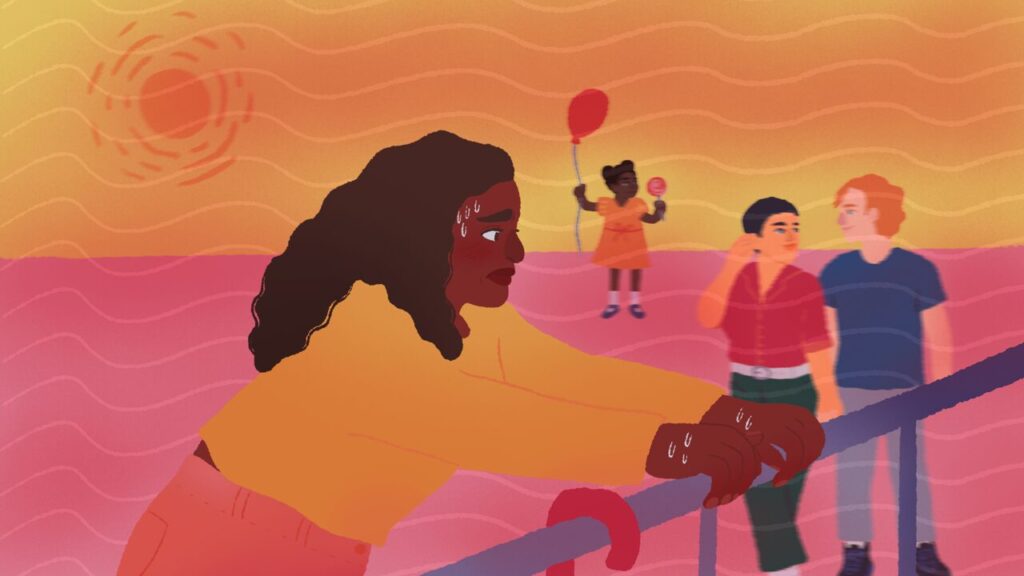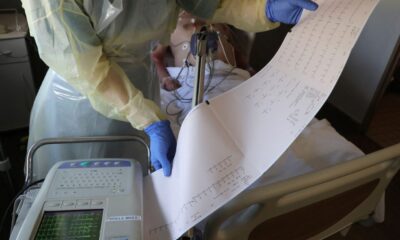Health
How extreme heat impacts disabled Americans differently

Degree by degree, the earth’s temperature ticks up. Heat records fall as reliably as the sun sets. In July, the East Coast broiled. This week, Texas and its neighbors are feeling the burn. It’s been an absolute scorcher in the United States, the hottest summer on record.
This summer might also be one of the coolest summers for the rest of your life.
Fossil fuel-induced climate change has transformed heat from a problem into a threat. Extreme heat kills more people than all other weather-related disasters combined. People with disabilities face even higher risk of injury or death during heat waves, especially since they are more likely to have less income and no air conditioning. Many parks and cooling centers are not accessible, too. So disabled people are often forced to adapt. The ability to stay cool in the face of many obstacles will prove invaluable as the world warms and the risk of hyperthermia, or heat stroke, increases.
STAT interviewed several people whose disabilities make it harder for them to withstand heat and navigate the summer months. Here are the stories of five people living in different corners of the country.
David Gissen, architecture professor
David Gissen has lived in New York for several years, but until recently, Gissen struggled to walk around New York City with his prosthetic leg — especially in the summer. Humans typically dissipate heat through their limbs. But that’s different when you have an amputation. Gissen likens it to a less powerful air conditioning system.
“When you wear an artificial limb, it encases that residual limb with a sealed, air-tight material,” said the Parsons School of Design architecture professor. “You don’t wrap your arms or legs in plastic when it’s hot outside. But when you’re an amputee, that’s how you wear a leg.”
His leafy neighborhood provides him with some shade, but every time Gissen thinks about venturing out into the city, he faces a grim calculus.
“If it’s really hot outside, I have to think: ‘do I want to go outside?’ Walking around on my leg is really taxing. I get dizzy, I start getting heat exhaustion,” said Gissen, who wrote about these experiences in, “The Architecture of Disability.”
Two years ago, he called up David Balsley. When Gissen was 16, the physical therapist taught him how to walk after doctors amputated his left leg during a childhood bout with bone cancer. Four decades later, Gissen was hoping his erstwhile mentor could work his magic again — and it worked. Balsley taught him how to run on a prosthetic leg, which has helped him walk more efficiently.
But the heat keeps rising, forcing Gissen back indoors.
“I’ve hit a wall,” he said. “Two or three summers ago, exercising worked great. But we’ve had three heat waves within 35 days. I can’t keep up. I don’t have the capacity to go outside when it’s hot like this and do the things that other people who have two legs can do.”
Gissen often consults for museums, and he said that one of the most impactful things institutions could do for people with disabilities is help people beat the heat. For example, turn places like the Metropolitan Museum of Art or the Natural History Museum into free cooling centers once the thermostat breaks 90°.
“That would create a kind of culture around the city that acknowledges the fact that these heat waves cause us to spend more time by ourselves to be isolated inside our homes, providing we have air conditioning, and that we need ways to interact with each other,” said Gissen.
Patty Glatfelter, retired physical therapist
When Patty Glatfelter got diagnosed with multiple sclerosis in 1980, she was a physical therapist living in Humboldt County — a part of California famous for fog, towering redwoods and secluded marijuana farms.
“For MS, it was probably an ideal environment, but even there, you could get into 80° heat with a half hour drive. I could turn some of my MS symptoms on and off just by going inland,” said Glatfelter.
Above 80° her sensory and motor systems break down. Feet, numb. Limbs, shaky. Nausea, rising. MS disrupts the body’s ability to send messages along its nervous system. Even half a degree rise in body temperature can further impede nerve functioning and exacerbate MS symptoms. So after decades of treating people who pushed it too far and living with a disability of her own, Glatfelter, an avid hiker and longtime triathloner, slowed her pace.
“My personality is one that I was always kind of trying to maximize. And I had to learn that sometimes minimizing is better. It only takes doing that once or twice to realize you can’t,” she said.
But even with that awareness, Glatfelter can’t choose when lightning strikes. On a recent visit to Santa Fe to check out art galleries, “we were just walking down the street, waiting at a stop light, and I could feel myself starting to get weaker, so I started looking for a shady spot,” she said. “And then, all of the sudden, my legs just went kaputt, and I was falling to the sidewalk.”
Fortunately, Glatfelter and her husband retreated to a nearby gallery and cooled off. But that “short-circuiting” ended her day. Her lights flickered, and then the power went out. So now she’s always got a plan. If she’s going to be in the heat, she knows in advance where she can escape to cool off and has plenty of devices — neck fans, ice pack-stuffed vests, frozen gel-pads in her hat — to help her. But even fully kitted out, Glatfelter will never stay outside for more than a couple hours.
Her disability spurred her family’s move to Pike’s Peak in Colorado in 2008 — even in the crush of summer, the average temperature rarely escapes the 70s. She likens herself to the small rodents that scurry around in the high altitude. Pikas perish in 80° heat after just a few hours.
“I grew up in Colorado, I knew what the heat was like, and it’s not like it is now. It’s something that people with disabilities are having to be quicker adapters with,” she said. “Because if we don’t adapt, we really suffer consequences.”
e.k. hoffman, policy advisor
Rugby, rowing, longboarding, biking — the list of e.k. hoffman’s former hobbies reads like an overachieving college athlete’s CV. So in mid-July, when another sweltering 95° degree day in Columbia, South Carolina had trapped them inside their home, hoffman decided to pay homage to that life. They made a digital grief collage out of old photos.
“My sibling lives with me and when they moved in last October, they would ask if I wanted to go on a walk or hike. Realizing I can’t even accept a walk down the street, it just made me feel a lot of grief,” said hoffman, an activist and senior policy advisor at New Disabled South.
Four years ago, hoffman was diagnosed with a selective immunoglobulin A deficiency, which weakens their immune system. To stay safe, they wear a mask when outside, but that traps heat. They also take antipsychotics, which can inhibit the body’s sweat production, and a beta blocker, which reduces blood flow to the skin. Dilating the blood vessels close to the skin is one of the body’s cooling mechanisms, so heat can build up when this is not an option.
So hoffman overheats at the smallest activity, even cleaning their kitchen. Direct sunlight is particularly ruinous. If they are caught in it for more than a minute, they have to sit down in the shade and furiously glug water.
Two years ago, they went to a South American festival with friends outside of Columbia. “I ended up passing out in cute rodeo clothes,” they said. “So much water, an umbrella, sunhat, ice packs. But I just didn’t make it. I barely hit an hour.”
When they woke up after fainting, hoffman had ice packs under their knees and a friend feeding them electrolytes and Tajín-ed pineapple. The experience put the nail in the coffin for their outdoor life and helped them embrace an indoor life that relies on friendship and mutual exchange. Their friend and single parent needed money to move, so hoffman ran a fundraiser from their home. They’ve also started holding “disabled joy spaces,” where they’ll gather with friends over Zoom and host fashion shows or craft parties.
“Community is the way that I can exist. My neighbor cut my lawn last week. I’ll watch their kids probably next week,” said hoffman. “There’s just no liberation unless you find a way where no body or mind is left behind. And what makes me feel held by a community and able to be disabled during these hotter months, is knowing that nobody is gonna leave me behind.”
Theresa Marie Collins, home health aide
At 55, Theresa Marie Collins was a self-described “superwoman.” The former NASA engineer and retired home health aide was a community fixture in a Houston suburb. She handed out food, volunteered in local elections and was a fixture playing dominoes at her local Catholic Charities.
But three years later, she had to dramatically curtail her activities in the summer. She drowns in the heat. Collins suspects her diabetes is partly to blame, as it can indirectly affect sweat glands and make it harder to cool off. But she suspects that she has a genetic predisposition to heat intolerance, as well: her sister and her brother had trouble with heat at a similar age.
Collins now hibernates in the summer. She has to. The dizziness, headaches, fatigue and other symptoms chase her out of the heat in minutes. Most days, she parks herself in front of the air conditioning unit, calls friends and watches daytime TV.
Except in early July, when she lost power for eight days.
Hurricane Beryl barreled through southern Texas, killing 23 people and overwhelmed the local energy grid, leaving millions of people without electricity. The city set up cooling centers, but Collins and many other Texans still had to sleep in the sweltering heat — or try to. Every 30 minutes Collins had to douse herself in water to keep from overheating.
“I don’t believe I could have made it another week. It was like a cumulative [increase] in my body temperature. I was so delirious, and I didn’t realize it,” she said.
The cooling centers had water but lacked food, so Collins called in favors and had caterers deliver pasta salad, cornbread, pizza and other food to the cooling center so people would not starve while CenterPoint Energy, the local utility, tried to get their system back online.
“Any time you have a fire or whatever, I’m the type of person you wanna be around because I always have a scenario in my brain ahead of time,” said Collins. “So when [Beryl] came up, I already had a plan of action. It’s not like, ‘Oh, I’m panicking.’ No, I’m trying to figure out what to do.”
Collins will likely have to troubleshoot again in the future. As sea temperatures rise, supercharged hurricanes will become more common, and Texas is the only state with its own power grid, leaving it to weather these storms on its own.
Jocelyn Mondragon-Rosas, graphic designer
Jocelyn Mondragon-Rosas would do anything for her family.
“If you talk to my siblings then everyone will tell you that I’m the one that keeps that communication going,” said Mondragon-Rosas, a graphic designer and disability advocate. “I’m not necessarily the glue, but I will force the glue between my family like I love them so much.”
The one thing she won’t do for her siblings and mother? Stay in her native Louisiana. After spending 27 years in the state, Mondragon-Rosas moved to Los Angeles in 2022. If she hadn’t, she would have had to stay house-bound due to arthrogryposis, a chronic condition which leads to stiff joints and a reduced range of motion. She can walk, but southern Louisiana’s tropical climate is sticky, soup-y and wet and leads to excessive sweating that quickly complicates her life.
“My fingers are crooked, so if I’d be sweating, it would make it hard for me to do hygiene things like bring myself to the bathroom to be able to pull down my pants. It would make it hard for me to stand up or sit down,” she said.
Her powered wheelchair helps her get around, but in rural Louisiana just south of New Orleans, the chair doesn’t have the same utility. As a kid, Mondragon-Rosas’ family didn’t have the money to buy a van that could accommodate her chair. She also shied away from using it because the chair’s metal parts can get scorching hot. She spent most of her life inside their family’s trailer, parked in front of the only AC unit.
When Hurricane Ida hit the region in 2021, this strategy unraveled. Their home lost power for a month, so they had to stay with a family friend. Mondragon-Rosas couldn’t stay cool.
“They would have to give me showers almost every day because the sweat was so bad. I would get these terrible migraines. My body was aching. I remember I had to be carried to a bunch of places because I couldn’t walk that well,” she said.
Mondragon-Rosas moved to Los Angeles to escape the grief of that time, gain more independence and live in a more optimal climate. She is still uncomfortable in the LA heat because she needs to wear long sleeves, which she can bite to lift up her arms with her mouth if she needs to reach something.
“Disabled people, we’re adaptive as f—,” she said.
The longtime Louisianan still plans to spend a lot of time back in the South with her family.
“If Louisiana had everything that California has so far offered me, I’d live there tomorrow,” she said. “My family is growing in Louisiana, my [cousin] had babies, and I haven’t met them yet. To not even get to be a part of their life every day — that’s so hard.”
STAT’s coverage of disability issues is supported by grants from Robert Wood Johnson Foundation and The Commonwealth Fund. Our financial supporters are not involved in any decisions about our journalism.













